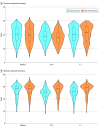Association of a Perioperative Multicomponent Fall Prevention Intervention With Falls and Quality of Life After Elective Inpatient Surgical Procedures
- PMID: 35275166
- PMCID: PMC8917421
- DOI: 10.1001/jamanetworkopen.2022.1938
Association of a Perioperative Multicomponent Fall Prevention Intervention With Falls and Quality of Life After Elective Inpatient Surgical Procedures
Abstract
Importance: Falls after elective inpatient surgical procedures are common and have physical, emotional, and financial consequences. Close interactions between patients and health care teams before and after surgical procedures may offer opportunities to address modifiable risk factors associated with falls.
Objective: To assess whether a multicomponent intervention that incorporates education, home medication review, and home safety assessment is associated with reductions in the incidence of falls after elective inpatient surgical procedures.
Design, setting, and participants: This prospective propensity score-matched cohort study was a prespecified secondary analysis of data from the Electroencephalography Guidance of Anesthesia to Alleviate Geriatric Syndromes (ENGAGES) randomized clinical trial, which was conducted at a single academic medical center between January 16, 2015, and May 7, 2018. Patients in the intervention group of the present study were enrolled in either arm of the ENGAGES clinical trial. Patients in the control group were selected from the Systematic Assessment and Targeted Improvement of Services Following Yearly Surgical Outcomes Surveys prospective observational cohort study, which created a registry of patient-reported postoperative outcomes at the same single center. The propensity score-matched cohort in the present study included 1396 patients (698 pairs) selected from a pool of 2013 eligible patients. All patients underwent elective surgical procedures with general anesthesia and had a hospital stay of 2 or more days. Data were analyzed from January 2, 2020, to January 11, 2022.
Interventions: The multicomponent safety intervention (offered to all patients in the ENGAGES clinical trial) included patient education on fall prevention techniques, home medication review by a geriatric psychiatrist (with communication of recommended changes to the surgeon), a self-administered home safety assessment, and targeted occupational therapy home visits with home hazard removal (offered to patients with a preoperative history of falls).
Main outcomes and measures: The primary outcome was patient-reported falls within 1 year after an elective inpatient surgical procedure. The secondary outcome was quality of life 1 year after an elective surgical procedure, which was measured using the physical and mental composite summary scores on the Veterans RAND 12-item health survey (score range, 0-100 points, with 0 indicating lowest quality of life and 100 indicating highest quality of life).
Results: Among 1396 patients, the median age was 69 years (IQR, 64-75 years), and 739 patients (52.9%) were male. With regard to race, 5 patients (0.4%) were Asian, 97 (6.9%) were Black or African American, 2 (0.1%) were Native Hawaiian or Pacific Islander, 1237 (88.6%) were White, 3 (0.2%) were of other race, and 52 (3.7%) were of unknown race; with regard to ethnicity, 12 patients (0.9%) were Hispanic or Latino, 1335 (95.6%) were non-Hispanic or non-Latino, and 49 (3.5%) were of unknown ethnicity. Adherence to individual intervention components was modest (from 22.9% for completion of the self-administered home safety assessment to 28.2% for implementation of the geriatric psychiatrist's recommended medication changes). Falls within 1 year after surgical procedures were reported by 228 of 698 patients (32.7%) in the intervention group and 225 of 698 patients (32.2%) in the control group. No significant difference was found in falls between the 2 groups (standardized risk difference, 0.4%; 95% CI, -4.5% to 5.3%). After adjusting for preoperative quality of life, patients in the intervention group had higher physical composite summary scores (3.8 points; 95% CI, 2.4-5.1 points) and higher mental composite summary scores (5.7 points; 95% CI, 4.7-6.7 points) at 1 year compared with patients in the control group.
Conclusions and relevance: In this cohort study, a multicomponent safety intervention was not associated with reductions in falls within the first year after an elective surgical procedure; however, an increase in quality of life at 1 year was observed. These results suggest a need for other interventions, such as those designed to increase adherence, to lower the incidence of falls after surgical procedures.
Conflict of interest statement
Figures



